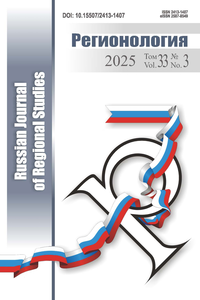M. Yu. Kazakov. Gravitational Interaction between the Center and the Periphery in an Agro-Industrial Region: Diagnostics of Spatial and Economic Drift of Territories
UDK 3 32.1
DOI: https://doi.org/10.15507/2413-1407.106.027.201901.030-057
Introduction. The study is of relevance due to the need to expand the theoretical developments in the field of spatial economics within the regional system in order to form adequate and flexible measures to stimulate and support the subjects of the intraregional environment. With regard to the state authorities’ growing interest in the tendencies of spatial development of territories, a careful analysis of the full diversity of processes and connections that take place within individual regions is necessary. The purpose of the study is to identify and analyze these processes.
Materials and Methods. The information and empirical base of the study included statistical data presented on the official website of the regional Department of Statistics in the Stavropol Territory and its municipal units. Fundamental methods of scientific knowledge were employed, the gravitational model was applied, and the tools of correlation and regression analysis were used to test hypotheses and calculated conclusions.
Results. For the first time, analytical data were obtained on the level, strength and direction of the spatial gravitation between the center and the peripheral territories in an agro-industrial region – the Stavropol Territory. The gravitational model adapted for studying the spatial processes of interaction of the ‘center–periphery’ system was for the first time tested in the conditions of an agro-industrial region. On the basis of the theory of gravitational environments, conclusions were drawn about the presence of specific processes in the region in the form of establishment of ‘the second-order’ gravitation centers, which are ‘beacons’ for the periphery due to a higher level of socio-economic development and general territorial remoteness from the main regional center.
Discussion and Conclusion. The implementation of the presented diagnostic approach made it possible to put forward a number of hypotheses about the presence and specificity of the spatial connections between the objects of the regional ‘center–periphery’ system. The force of gravitation, the direction and type of the spatial drift can have a direct impact on the level of socio-economic development of the periphery. The specified factors affect the overall ‘survival’ potential of the peripheral territories. The results of the study are of practical importance and can be used as the empirical justification for program projects aimed at stimulating development of regions.
Keywords: peripheral territories, regional economy, gravitational model, spatial drift, economic space
REFERENCES
1. Zemtsov S.P., Baburin V.L. Assessing the Potential of Economic-Geographical Position for Russian Regions. Ehkonomika regiona = Economy of Region. 2016; 12(1):117-138. (In Russ.) DOI: https://doi.org/10.17059/2016-1-9
2. Granberg A.G. [Formation of the Scientific Field of “Spatial Economics” in Russia]. Vestnik Universiteta (Gosudarstvennyj universitet upravleniya) = The University Bulletin (State University of Management). 2009; 2(26):18-24. Available at: https://elibrary.ru/item.asp?id=12903552 (accessed 16.04.2018). (In Russ.)
3. Granberg A.G. Conceptual Base of the Program on Fundamental Issues of Spatial Development: Interdisciplinary Aspect Issued by the Presidium of the Russian Academy of Sciences. Region: ehkonomika i sotsiologiya = Region: Economics and Sociology. 2009; (2):166-178. Available at: http://recis.ru/index.php/region/index/2009 (accessed 13.05.2018). (In Russ.)
4. Klebanova T.S., Guryanova L.S., Trunova T.N., Smirnova A.Yu. Estimation and Analysis of Unbalanced Regional Development in Ukraine. Аktualnye problemy ehkonomiki = Topical Issues of Economics. 2009; (5):162-167. Available at: http://dspace.ubs.edu.ua/jspui/bitstream/123456789/843/1/klebanova_estim... (accessed 13.05.2018). (In Russ.)
5. Brakman S., Garretsen H., Gorter J., Horst A. van der, Schramm M. New Economic Geography, Empirics and Regional Policy. CPB Netherlands Bureau for Economic Policy Analysis. 2005. Available at: http://www.kdi.re.kr/data/download/attach/8471_cu8469-1-2.pdf (accessed 21.08.2017).
6. Capello R. Regional Economics in its 1950s: Recent Theoretical Directions and Future Challenges. The Annals of Regional Science. 2008; 42(4):747-767. DOI: https://doi.org/10.1007/s00168-007-0185-8
7. Combes P.P., Mayer T., Thisse J.-F. Economic Geography: The Integration of Regions and Nations. Princeton : Princeton University Press. 2008; 416 p. Available at: https://press.princeton.edu/titles/8765.html (accessed 02.11.2018).
8. Hanson G. Market Potential, Increasing Returns, and Economic Concentration. Journal of International Economics. 2005; 67(1):1-24. DOI: https://doi.org/10.1016/j.jinteco.2004.09.008
9. Garretsen H., Martin R. Rethinking (New) Economic Geography Models: Taking Geography and History More Seriously. Spatial Economic Analysis. 2010; 5(2):127-160. DOI: https://doi.org/10.1080/17421771003730729
10. Masot A.N., Alonso G.C. The Rural Development Policy in Extremadura (SW Spain): Spatial Location Analysis of Leader Projects International. Journal of Geo-Information. 2018; 7(2):76. DOI: https://doi.org/10.3390/ijgi7020076
11. Colin J. Spatial Economy and the Geography of Functional Economic Areas. Environment and Planning B: Urban Analytics and City Science. 2017; 44(3):486-503. DOI: https://doi.org/10.1177/0265813516642226
12. Delgado M., Porter M.E., Stern S. Clusters and Entrepreneurship. Journal of Economic Geography. 2010; 10(4):495-518. DOI: https://doi.org/10.1093/jeg/lbq010
13. Head K., Mayer T. The Empirics of Agglomeration and Trade. The Handbook of Regional and Urban Economics. 2004; 4:2609-2669. Available at: https://econpapers.repec.org/bookchap/eeeregchp/4-59.htm (accessed 21.04.2018).
14. Setyono J.S., Yunus H.S., Giyarsih S.R. The Spatial Pattern of Urbanization and Small Cities Development in Central Java: A Case Study of Semarang-Yogyakarta-Surakarta Region. Geoplanning: Journal of Geomatics and Planning. 2016; 3(1):53-66. DOI: https://doi.org/10.14710/geoplanning.3.1.53-66
15. Zhong Ch., Schläpfer M., Arisona S.M., Batty M., Ratti C., Schmitt G. Revealing Centrality in the Spatial Structure of Cities from Human Activity Patterns. Urban Studies. 2017; 54(2):437-455. DOI: https://doi.org/10.1177/0042098015601599
16. Shumilov A.V. Estimating Gravity Models of International Trade: A Survey of Methods. Ehkonomicheskij zhurnal vysshej shkoly ehkonomiki = HSE Economic Journal. 2017; 21(2):224-250. Available at: https://ej.hse.ru/2017-21-2/207118214.html (accessed 20.05.2018). (In Russ.)
17. Potapova I.A., Boyarshinova I.N., Ismagilov T.R. Methods of Traffic Flow Modeling. Fundamentalnye issledovaniya = Basic Research. 2016; (10-2):338-342. Available at: https://fundamental-research.ru/ru/article/view?id=40856 (accessed 25.05.2018). (In Russ.)
Submitted 20.09.2018; accepted for publication 26.10.2018; published online 29.03.2019.
About the author:
Mikhail Yu. Kazakov, Doctoral Candidate, Department of Economics and Foreign Economic Activity, North-Caucasus Federal University (1 Pushkina St., Stavropol 355009, Russia), Ph. D. (Economics), ORCID: https://orcid.org/0000-0002-0297-6299, Researcher ID: http://www.researcherid.com/rid/R-1486-2018, lyasay21@yandex.ru
For citation:
Kazakov M.Yu. Gravitational Interaction between the Center and the Periphery in an Agro-Industrial Region: Diagnostics of Spatial and Economic Drift of Territories. Regionologiya = Regionology. 2019; 27(1):30-57. DOI: https://doi.org/10.15507/2413-1407.106.027.201901.030-057
The author has read and approved the final version of the manuscript.

Материалы журнала "РЕГИОНОЛОГИЯ REGIONOLOGY" доступны по лицензии Creative Commons «Attribution» («Атрибуция») 4.0 Всемирная
















